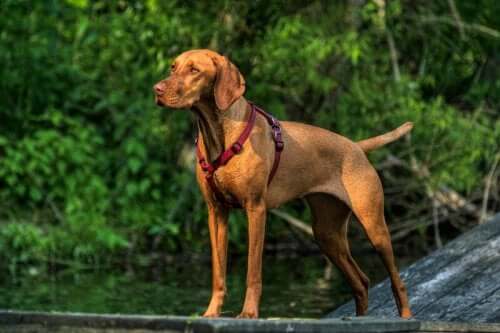The Hungarian Vizsla: An Old European Hunting Dog

Out of all the oldest European hunting dogs, the Hungarian Vizsla is, without a doubt, near the top of the list. Also known as the Hungarian Pointer, it’s a very fast dog with a great sense of smell. It stands out for its skill as a pointer, tracker, flusher, and retriever.
What’s more, this breed has the ability to handle any type of terrain, including water. These beautiful canines also stand out in demonstration exercises and in obedience and agility tests. Therefore, Vizslas make for great household pets as well.
The Hungarian Vizsla, a millennial dog
History provides knowledge regarding the existence of this breed throughout the Maygar region for the past thousand years. Hungarians interacted with the Finnish and with Estonians who inhabited the Asian and European steppes of the East in order to conquer the Carpathian Basin, where they introduced a breed that came to be the modern-day Vizsla.

That’s why it’s very likely that these animals mated with dogs from Central Europe, such as the Transylvanian Hound. Later, along with the Turkish occupation of 1526, yellow pointers arrived in the region, which also mixed with the Vizsla.
The Hungarian Vizsla, or Hungarian Pointer, is a hunting dog with many centuries of history. What’s more, it’s considered an excellent companion, standing out for its loyal, gentle, docile, and friendly character .
A dog with aristocratic airs
This elegant breed has an aristocratic appearance and a life expectancy of between 12 and 14 years. It’s longer than it is tall, and also possesses the following characteristics in regards to its physique:
- Size: medium to large in size
- A well-proportioned body – slender but muscular and athletic
- The height at its withers: between 23 and 25 inches in males, and between 21 and 24 inches in bitches.
- Weight: between 48 and 66 pounds
- Vizslas have short, straight, dense, and hard fur that comes in a variety of shades of yellow
- They have firm skin that is absent of wrinkles and folds
- These canines have a relatively long snout that is generally square-shaped. It narrows gradually towards the tip
- Ears: thin, silky, and long – they hang close to the animal’s cheeks.
- Eyes: medium in size, brown in color, and oval in shape.
- Tail: long, wide at the base, and with low insertion. Traditionally, breeders and owners would cut their tails – however, this is now illegal in a great number of countries.
The temperament of the Hungarian Vizsla
While these dogs worked as hunting dogs for centuries, man has always considered them an excellent companion as well. They are very sweet animals with a pleasant personality and are very loyal and dependent on their owners. For this very reason, it’s best not to leave them alone for too long, as they may suffer separation anxiety.
In addition, these canines are smart, caring, and docile. They get along just fine with children and with other dogs as well. Hungarian Vizslas don’t bark excessively and they stand out as curious and dynamic animals. If they receive the right kind of training, they learn very quickly and become quite obedient pets.

In this regard, it’s important to point out that these dogs need a good amount of time to play and exercise each day… at least an hour. Therefore, rural areas are the ideal setting for Hungarian Vizslas. If that’s not the case, then homes should have least have a yard or patio. Otherwise, these animals can easily become bored and develop destructive behavior inside their homes.
Caring for the Hungarian Vizsla
The Vizsla is a canine that doesn’t have any tendencies to specific health problems. Just the same, they may develop the following:
- Elbow or hip dysplasia
- Epilepsy
- Sebaceous adenitis
- Hypothyroidism
- Progressive atrophy of the retina
- Liposarcoma
- Skin allergies
Like any other pet, owners should take their Hungarian Vizslas for regular veterinarian visits for vaccinations and worming. Each animal’s vet will be able to make specific indications in this regard.
It’s important to point out the advantage of the fact that their fur is very easy to care for. In fact, a simple brushing every once in a while will suffice, and they only need baths when they’re very dirty.
Sources of images: Bryon Realey, Issigonis and Tomer Jacobson